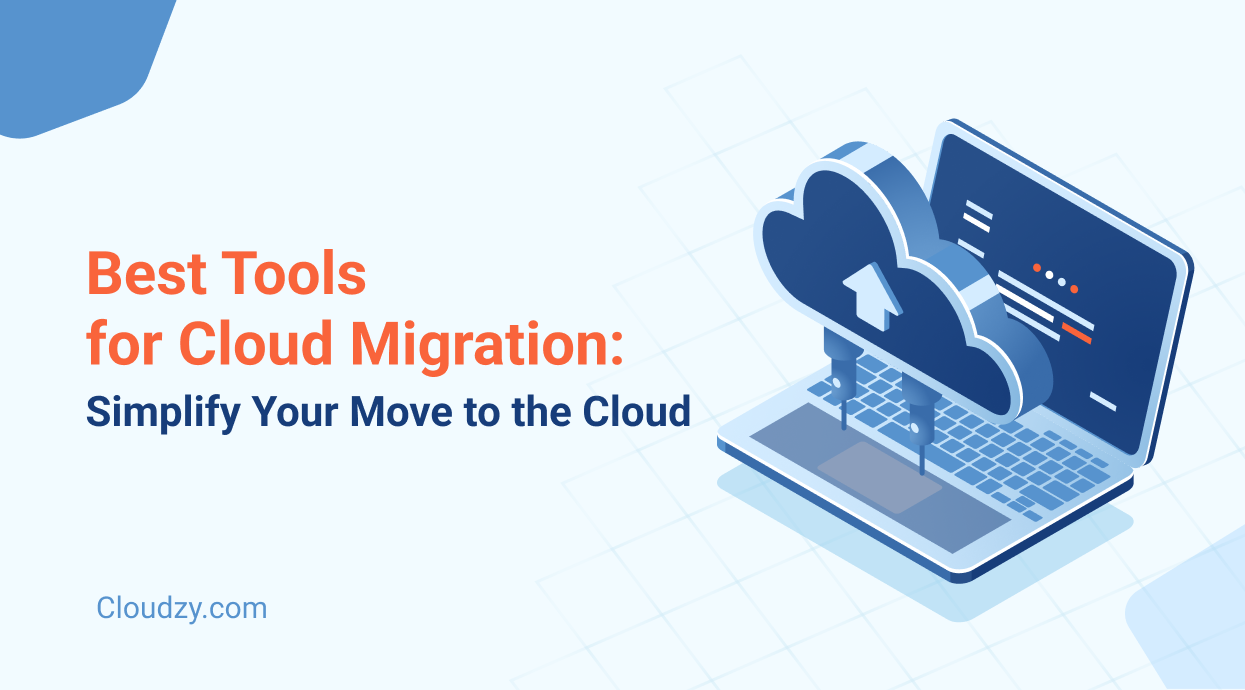In the world of software development today, increasing numbers of enterprises wish to migrate to cloud computing to gain anything from storage to processing, all of which previously meant building their own data centers, a not so convenient option for many companies. However, cloud adoption itself is a huge challenge since it involves changes in both the architecture of the enterprise system and the workflow.
Here is where cloud migration tools help: they allow the transition from traditional on-premises systems to the cloud to be a lot simpler.
What is Cloud Migration?
Cloud migration refers to the process of transferring on-premise data, applications, and infrastructure to the cloud to do things such as scaling, flexibility and with the chances it creates, to be more cost-efficient. It includes service models such as SaaS or Software as a Service (ready-to-use apps), PaaS or Platform as a Service (development platforms), and IaaS Infrastructure as a Service (virtualized infrastructure). Deployment can vary among private, public, hybrid, and community clouds, depending on organizational needs and security requirements.
Effective cloud migration strategies—such as rehosting, refactoring, replatforming, or replacing—are essential for a smooth transition and long-term success. As businesses adopt multiple cloud platforms to avoid vendor lock-in and optimize performance, multi-cloud management becomes crucial for maintaining visibility, cost control, and interoperability across different environments.
Key Aspects of Cloud Migration Tools
Cloud migration tools ease and smooth the transition of data, applications, and workloads from the on-premises infrastructure to the cloud. Here are the main features in cloud migration tools:
Useability
Cloud migration tools need to be intuitive and have an easy-to-navigate interface so that teams can manage the migration process with very little learning curve.
Many tools are equipped with automation capabilities, reducing manual work. That, of course, makes for a simpler migration process.
Assessment and Planning
Cloud migration tools should determine the extent to which its infrastructure is ready for cloud adoption, including workload, dependency, and security assessment.
Some tools come with pointers to the suitable migration strategy for example, rehosting, refactoring, replatforming and so on.
Data Migration
These tools must ease the transfer of large data whether databases, file systems, or application data to the cloud, and to do so without many downtimes.
They must make sure that the integrity of data being transferred into a system under strict validation processes for data accuracy.
Compatibility
Tools must work across various platforms due to the identity of so many cloud providers under many organizations either in public, private or hybrid deployments.
Security and Compliance
To prevent unauthorized access, the migration process should protect data by encrypting it in transit and at rest.
Also, the migration tool should comply with specific laws (GDPR, HIPAA, etc.) and support audit for compliance purposes.
Cost Management
Cloud migration tools should be able to offer estimates on costs so that businesses can begin realizing what their potential cloud costs ahead.
Some tools will then check the cost-optimized usage of cloud resources whenever there is an opportunity.
Migration Automation
The automation capabilities make sure that repetitive tasks get done without human intervention, which improves efficiency and rejects human errors.
Monitoring and Reporting
These tools provide insights into the migration process, highlighting any potential issues.
They offer detailed reports on migration progress, data integrity, and post-migration performance.
Scalability
These tools offer support in scaling up with the growing workload or business, that is, transitioning from a small-scale migration to large-scale cloud adoption without much change in strategy.
Post-migration Support
Post-migration support by cloud migration tools to validate the system is optimized for performance, security, and cost.
10 Top Cloud Migration Tools Based On Category
The best tool for migrating to the cloud can simplify the entire process. Here are some of the top cloud migration tools list, each suited to specific portions of cloud migration.
These tools are aimed at scanning organizations’ existing on-premise infrastructure and workloads to be migrated into the cloud. They analyze and recommend the best route for migration, estimate costs, and prepare a migration roadmap.
AWS Migration Hub
Company: Amazon Web Services (AWS)
AWS Migration Hub provides a centralized place for tracking progress in the journey towards cloud migration. By integrating with other AWS and third-party tools for migration, it provides a view into the migration process itself.
Pros of AWS Migration Hub:
- Tracking migrations in one place
- Works with all AWS services
- In detailed reports, each stage of the migration process is tracked
Cons of AWS Migration Hub:
- Limited to AWS environment
- May not provide details at a deep level on application insights
Azure Migrate
Company: Microsoft
Azure Migrate helps businesses assess, plan, and move workloads to Microsoft Azure, comes with discovery capabilities to enable on-premises workloads and recommend appropriate migration.
Pros of Azure Migrate:
- Compatibility with multiple cloud platforms
- Free tool for Azure users
- Provides in-depth assessment and cost analysis
Cons of Azure Migrate:
- Offers limited integration with non-Microsoft cloud providers
- Has a steep learning curve for new users
Data Migration Tools for Cloud Migration
These tools handle the transfer of large volumes of data to the cloud. They assist in moving files, databases, and other types of data from on-premises storage to a target cloud platform-from any source location.
AWS DataSync
Company: Amazon Web Services (AWS)
AWS DataSync is designed to automate and speed up transferring data between on-premise storage and AWS. It is suitable for large-scale data migrations and works with different AWS storage services.
Pros of AWS DataSync:
- High-speed transfer of data
- On-the-fly encryption ensures data security
- Easy integration with AWS storage solutions
Cons of AWS DataSync:
- AWS environment-dependent
- Costs can grow with larger data volumes
Azure Data Box
Company: Microsoft
A data box is a physical device to transfer massive amounts of data to Azure. It is ideal for scenarios in which the internet transfer is too slow or impractical.
Pros of Azure Data Box:
- Excellent solution for offline large data migration
- Simple deployment of the physical device
- Secured with encryption
Cons of Azure Data Box:
- Managing the physical device and shipping it can be time-consuming
- Some constraints on real-time data migration
Application Migration Tools for Cloud Migration
These tools support on-premise application migration to the cloud as in migration of an application without changes or application replatforming.
AWS Application Migration Service
Company: Amazon Web Services (AWS)
AWS Application Migration Service (previously Server Migration Service) helps simplify and automate replication of on-premises servers to AWS for easy lift-and-shift migrations.
Pros of AWS Application Migration Service:
- Less downtime while migrating
- Server replication automation
- Easy use for legacy applications
Cons of AWS Application Migration Service:
- Cloud-locked to AWS
- Some applications may need fine adjusments
Azure Site Recovery
Company: Microsoft
Azure Site Recovery eases disaster recovery from on-premises physical or virtual machines to Azure. It includes migration of applications and services to Azure.
Pros of Azure Site Recovery:
- It provides business continuity and disaster recovery
- Integration with Azure Active Directory
- It has support for many OS and application
Cons of Azure Site Recovery:
- More focused on disaster recovery rather than big migrations
- Complex configuration requirement in case of non-Azure environments
Cloud Security Migration Tools for Cloud Migration
The security migration tools are customized for the security of applications, data, and infrastructure during the cloud migration process. These tools ensure the integrity, confidentiality, and availability of data when migrating sensitive data.
McAfee Cloud Migration
Company: McAfee
The McAfee Cloud Migration is a set of migration tools ensuring that data and workloads transition safely to the cloud, embedding encryption and threat prevention.
Pros of McAfee Cloud Migration:
- Strong security, including encryption
- Always-on threat monitoring
- Good integration with the rest of the McAfee security solutions
Cons of McAfee Cloud Migration:
- Security-oriented, not full-fledged migration
- Strong focus on the McAfee user base
Prisma Cloud
Company: Palo Alto Networks
Prisma Cloud applies security regulations during migration by securing data and workloads as they are released into the cloud.
Pros of Prisma Cloud:
- Provides security monitoring across the board
- Works in multi-cloud environments
- Assists in regulatory compliance
Cons of Prisma Cloud:
- Expensive for small companies
- Needs constant security management and expertise
Cost Management and Optimization Tools for Cloud Migration Tools
These tools deal with measuring and managing costs related to migration to the cloud optimizing such costs. It tracks usages, optimizes the resources as well as forecasts the consumption of cloud computational costs within a specific period.
CloudHealth
Company: VMware
CloudHealth is a cloud cost management platform that helps businesses to control their cloud usage across multiple environments, thus ensuring cost-effective migration.
Pros of CloudHealth:
- Profound analysis of their cloud costs
- Support multiple cloud management costs
- Connects to leading cloud platforms
Cons of CloudHealth:
- Complex installation and setup
- Affordability can be a barrier to small companies
CloudCheckr
Company: CloudCheckr
CloudCheckr is a cost management and optimization platform for clouds, bringing visibility into cloud usage, cost analysis, savings recommendations, and policy compliance checks.
Pros of CloudCheckr:
- Support for multi-cloud environments
- Automated cost optimization recommendations
- Detailed monitoring of security and compliance
Cons of CloudCheckr:
- Complicated configuration for new users
- Costlier for small businesses or teams
Cloud Migration Tools Save-Ups
Moving towards the cloud can bring huge savings for businesses; however, such savings will vary over the operations scale, existing infrastructure, and exact cloud solutions that may be chosen. On average, businesses are likely to save in these areas:
| Cost Area | Savings Potential | Description |
| Infrastructure Expenses | 30% – 40% | On-premises hardware, software, and maintenance costs savings |
| Scalability and Flexibility | Up to 50% | For some businesses, just models of pay-as-you-go savings can be cost-effective, especially in cases where requirements increase |
| Labor and Operational Costs | Up to 25% | Minimizes staffing for IT and infrastructure management |
| Disaster Recovery & Backup | Significant savings | This built-in backup for disaster recovery saves systems and providers |
| Energy Savings | Significant savings | Data centers in clouds are more efficient than those outside and cost less on energy. |
| Software Upgrades & Licensing | Significant savings | The updates come with cloud services, and also decrease the need for these highly expensive software licenses |
The Final Word
Cloud migration stands to be a key step in modernizing IT infrastructure, while cloud migration tools can increase smoothness, security, and cost-effectiveness. The identification of the correct tools in areas including planning, actual data transfer, security, cloud load balancing, and cost management will ensure successful transformation and performance in the cloud for the long term.



